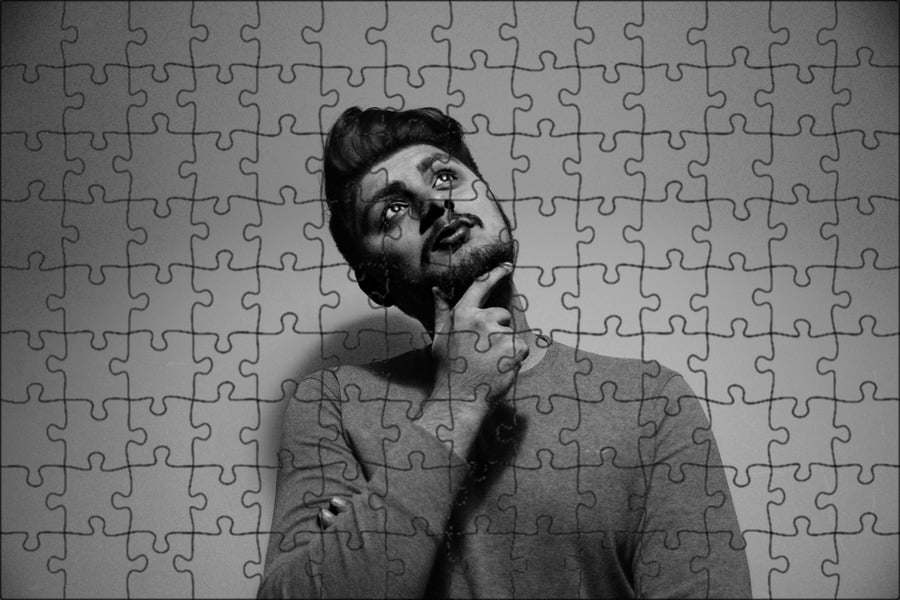There is a reason why most people don't live in Everest or the Mariana Trench because it's hard to survive in those extreme and harsh areas.
Most of us engage in bifurcated thinking from time to time. Some experts believe that this pattern may have an evolutionary role in human survival, but if black-and-white thinking usually continues, it will lead to:
- Damage to physical and mental health.
- Ruining a person's career.
- Disturbing their relationships.
Our next article will discuss how to identify black-and-white ideas, what they would tell you about your health, and what you can do to develop a more balanced outlook. So stay tuned.
What does it look like to think in black and white?
Some words can alert you that your thoughts have become extreme:
- Always.
- Never.
- Impossible.
- Catastrophic.
- Angry.
- Screwed.
- At best.
Of course, these words are not bad in themselves, but if you notice that they continue appearing in your thoughts and conversations, they may signal that you have adopted a black-and-white perspective on something.
How does black-and-white thinking hurt you?
1. It can hurt your relationships
Like relationships between individuals, whether they see each other as family, friends, neighbors, co-workers, or anything else, disagreements inevitably arise because people have different thinking, differences, and contradictions.
Suppose we deal with ordinary conflicts with dichotomous thinking. In that case, we may draw the wrong conclusions about others and lose the chances of negotiation and settlement. Worse, thinking in black and white may make a person make decisions without considering the impact of this decision on themselves and others concerned.
Examples may include:
- Suddenly, people moved from the category of “good people” to the category of “bad people.”
- Quitting work or firing people.
- Break off relation.
2. Avoid real resolution of issues
Bifurcated thinking often oscillates between idealizing and devaluing others, and it can be difficult to be in a relationship with someone thinking about extremism due to their oppressive, stubborn, and unquestionable opinions.
3. It may prevent you from learning
“I'm bad at math,” most math teachers hear this declaration over and over again during the school year. It's a product of a pass-or-fail mentality, a corollary to a grading system that defines failure (a score from 0 to 59) as more than half the final grade scale (100). Some grades even have a binary system for measuring learning, either success or failure, and it's very easy to fall into binary thinking about your academic achievements.

4. It can limit your career
Bifurcated thinking creates and adheres to precisely defined categories: my job, their job, my role, and their role in many collaborative work environments. Roles change, expand, and reshape. Strict boundaries may prevent you and the organization from achieving goals. A 2017 study that examined the work of a Dutch film studio found that some ambiguity in people's roles and responsibilities had positive general effects on the creative project. However, some differences emerged as people expanded their scope of work.
Black-and-white thinking hinders your life and stops your career progress. Many people lost their jobs in the economic crisis that occurred in 2008, and entire companies and institutions stopped supplying cadres and employees. Therefore, this forced many people to reconsider their skills and not stick to shallow and rigid ideas about their experiences and what they enjoy. Also, this opened many doors and much broader job opportunities, as a career is not fixed, and everyone can develop and learn.
5. It may abolish healthy eating habits
Several studies have found a link between eating disorders and dichotomous thinking; black-and-white thinking can lead to:
- Looking at some foods as good or bad.
- Seeing bodies as either perfect or disgusting.
- Eating in a way that either eats everything or does not eat anything.
Researchers have also found that dichotomous thinking can lead people to set strict dietary restrictions, challenging maintaining a healthy relationship with food.
Is black-and-white thinking a symptom of other disorders?
Some black-and-white thinking is normal, but persistent dichotomous thinking patterns are associated with several conditions, such as:
1. Narcissism (NPD)
- An exaggerated sense of self-importance.
- An urgent need for attention.
- A deep lack of compassion for others.
Extreme binary thinking is a symptom of narcissism. It makes it difficult for narcissists to accept help from anyone because, in their view, all the rapists or people, in general, are less than them, and their words and support are not helpful at all.
2. Borderline Personality Disorder (BPD)
The National Institutes of Mental Health defines borderline personality disorder as a mental illness that causes severe bouts of anger, depression, and anxiety.
People with borderline personality disorder:
- They usually have problems controlling reactions.
- They often think black and white.
- They may have problems with personal relationships.
A study found the tendency to think in opposite directions is at the heart of the problem experienced by many people with borderline personality disorder in their relationships.
3. Obsessive-Compulsive Disorder (OCD)
Some psychologists believe that people with OCD usually think of "all or nothing" patterns because the ability to put something in a black or white box gives them a sense of control over their circumstances, and dichotomous thinking makes people maintain strict perfectionism. If a person is experiencing a relapse, it is easier to view this as a complete failure of treatment rather than as a temporary impediment to overall progress.

4. Anxiety and Depression
People who are prone to anxiety and depression may tend to think in extremes and absolutes. A study in 2018 that examined the normal speech of people with anxiety and depression found more frequent use of “absolute” language among them than among normal groups. Thinking in black-and-white may cause rumination of thoughts, and this exacerbates anxiety or depression. It is also worth noting that researchers have found a relationship between black-and-white thinking and negative perfectionism. It appears when people deal with anxiety and depression.
5. Racism and Hate
Black-and-white thinking is believed to be the main cause of racial, sectarian, and social divisions. Extremism and racism always start by making judgments, such as This is black, this is white, this is Asian, this is African, this is European and other ideas of apartheid. These ideologies tend to stigmatize and degrade different people and ostracize them from a society based on extremist ideas without thinking about their effects and adhering to them.
What Causes Black-and-White Thinking?
Although personality disorders and mental health conditions are sometimes hereditary, there is insufficient research to conclude that black-and-white thinking is inherited. Yet, it has been linked to childhood or adulthood trauma. Researchers believe that when we experience trauma, we may develop bifurcated thought patterns as a coping strategy or to protect ourselves from future harm.
How can you change black-and-white thinking?
Black-and-white thinking can make things difficult for you personally and professionally, and it has been linked to treatable mental health conditions. For these reasons, speaking with a therapist or mental health professional is essential if you notice that extremist thinking affects your health, relationships, or mood. Working with someone who has been trained in cognitive behavioral therapy is effective in dealing with dichotomous thinking, and you may also find it helpful to try some of these methods:
1. Separate what you do from who you are
Comparing our performance on a single scale to our overall value makes us susceptible to black-and-white thinking.
2. The experience of refuting options
If black-and-white thinking has stuck you between just two outcomes or possibilities, write down several options you can imagine. If you're having trouble getting started, try coming up with at least three alternatives at first.
3. Practice remembering reality
When you feel paralyzed by black-and-white thinking, say or write down realistic and small statements, such as I can solve this problem in several ways. I will make a better decision if I get more information, and we may both be partially right.
4. Discover what others think
Black-and-white thinking can keep you from seeing things from someone else's perspective, so when you're in conflict with someone, calmly ask clarifying questions to come to a clear understanding of their point of view.
In conclusion
Black-and-white thinking is a tendency to think in extremes. While it's normal from time to time, developing a pattern of dichotomous thinking can interfere with your health, relationships, and career, and it's linked to anxiety and depression.
So, if you are constrained to think in black and white, it's important to talk to a therapist. A therapist can help you learn strategies for gradually changing this thought pattern and living a healthier, more fulfilling life.






Add comment